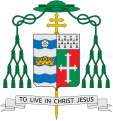Archivo:Coat of arms of John Francis Donoghue.svg

Este archivo es de Wikimedia Commons y puede usarse en otros proyectos. La descripción en su página de descripción del archivo se muestra debajo.
| DescripciónCoat of arms of John Francis Donoghue.svg |
English: Coat of arms of the U.S. Archbishop John Francis Donoghue, Archbishop of Atlanta (1993–2004).
The entire "achievement," or coat of arms as it is generally called, is composed of the shield with its charges, the motto and the external ornaments. As one looks at the shield the terms dexter (right) and sinister (left) must be understood contrariwise, as the shield was worn on the arm in medieval days and these terms were used in the relationship of the one bearing the shield. The dexter impalement is given in ecclesiastical heraldry to the arms of jurisdiction; in this instance, the arms of the Archdiocese of Atlanta. Atlanta known as the "Crossroads of the South," because of converging railroads which gave the city its early prominence, received its name as the eastern terminus of the Western and Atlantic Railroad which connected north Georgia with the Tennessee River. Originally called Whitehall, then Terminus, and afterwards in 1843 Marthasville, the state legislature finally acquiesced to the wishes of the railroad and accepted the name of Atlanta in 1847, thus naming the city indirectly after the Atlantic Ocean. The Atlantic Ocean is represented on the shield of the archdiocese by white and blue wavy bars, the heraldic equivalent of the waves of the sea; seven bars in number to symbolize the Seven Sacraments. The crown of Christ the King denotes the title of the cathedral church, the Eternal King whose redeeming Sacrifice on the Cross is renewed daily in the Holy Sacrifice of the Mass. Above the crown is placed the Cherokee rose, the State flower of Georgia (Rosa Laevigata), as befits an archdiocese located in the Capital City. The Cherokee rose is a white flower with a yellow center. The crown of Christ the King, in the arms of the Archdiocese of Atlanta, also has the secondary representation of the crown of King George II of England after whom Georgia was named. The blue and white wavy bands may be said as well to symbolize the rolling foothills of the Blue Ridge country; but, more important, these are the colors of our Blessed Mother. The sinister impalement, on the right of the viewer, bears the personal arms of Archbishop Donoghue. These consist of a field, or surface quartered green and red. The quartering is found in the arms of the Archdiocese of Washington, and commemorates Archbishop Donoghue's priestly ministry in that archdiocese. The green and red are the surface colors of the arms of the Irish septs of O'Donoghue and Ryan, and honor the Archbishop's paternal and maternal ancestry. The central charge of the arms is a silver (white) cross with its limbs terminating in a fleur-de-lis. This cross flory honors Archbishop Donoghue's baptismal patron, Saint John Vianney (1786-1859). The fleur-de-lis has long been a symbol of the Blessed Virgin Mary, and here joined to the cross, alludes to the Archbishop's Pauline motto and his devotion to Christ's Mother. The chief portion of the shield is ermine (white and black ermine tails) and commemorates Archbishop Donoghue's long association with Patrick Cardinal O'Boyle, second archbishop of Washington, whose arms bore an ermine chief. The motto, "To Live in Christ Jesus," has been adapted from Saint Paul's Epistle to the Philippians 1:21. In pale behind the arms is placed a gold archiepiscopal cross with a double transverse. A pontifical hat with ten tassels on each side disposed in four rows, all green, surrounds the shield ensigning the whole achievement. Prior to 1870, the pontifical hat was worn in solemn conclaves held in conjunction with papal functions. The color of the pontifical hat and the number and color of the tassels were signs of the rank of a prelate, a custom which is still preserved in ecclesiastical heraldry. Reference: Español: Escudo de armas del arzobispo estadounidense John Francis Donoghue, arzobispo de Atlanta (1993–2004).
Referencia: |
| Fecha | |
| Fuente | Trabajo propio |
| Autor | SajoR |
| Permiso (Reutilización de este archivo) |
Trabajo propio, reconocimiento requerido, mantener licencia:(Creative Commons CC-BY-SA-2.5). Citar a Wikipedia ó a Wikimedia como fuente si la imagen es utilizada en otros medios que no sean de los proyectos de la familia Wikipedia. I, SajoR, titular de los derechos de autor de esta obra, la publica en los términos de la siguiente licencia: Este archivo se encuentra bajo la licencia Creative Commons Genérica de Atribución/Compartir-Igual 2.5. Atribución: I, SajoR
|
Leyendas
Elementos representados en este archivo
representa a
Algún valor sin elemento de Wikidata
8 dic 2013
image/svg+xml
3882e91dca6a182ac5829ce5ca2f2b7de198ccdc
411 291 byte
1226 píxel
1150 píxel
Historial del archivo
Haz clic sobre una fecha/hora para ver el archivo a esa fecha.
| Fecha y hora | Miniatura | Dimensiones | Usuario | Comentario | |
|---|---|---|---|---|---|
| actual | 22:35 8 dic 2013 |  | 1150 × 1226 (402 KB) | SajoR | {{Information |Description ={{en|1=Coat of arms of the U.S. Archbishop John Francis Donoghue, Archbishop of Atlanta (1993–2004). The entire "achievement," or coat of arms as it is generally called, is composed of the shield with its charges, the... |
Usos del archivo
La siguiente página enlaza a este archivo:
Metadatos
| Anchura | 1150.325 |
|---|---|
| Altura | 1226.4028 |